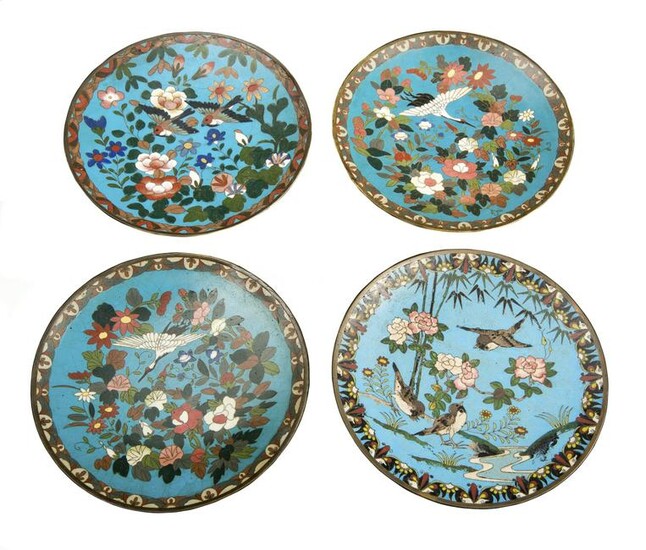Japanese Meiji Period Cloisonné Enamel Plates
Japanese Meiji Period Cloisonné Enamel Plates Cranes and Mandarins diamond.Japan, late Meiji Period, about 1890’s4 plates. Height 250 mm; Diameter 240 mm. Some damages, bowed with some cloisonné missing on the border area. Minor defects.
Further Details
Four attractive Japanese cloisonné enamel plates, dating from the late Meiji Period (1868-1912).Two plates depicts a crane in flight, the others depicts Mandarins diamond. They are surrounded by dense foliage, with lilies, chrysanthemums, peonies and camellia. The plates are finished with a tight border of scrolling floral and geometric patterns. In the diffusion of the cloisonné of the East, the greatest chromatic use was made in Japan. With the founding of the Arhens Company in Tokyo in 1875, the owners secured the collaboration of the most famous cloisonné artist Tsukamoto Kaisuke, and of Gottfried von Wagner, one of the western technologists transferred to Japan to improve traditional arts and crafts. With his experimentation, Wagner had the enamel technique take another step towards a modern and scientific practice of this art, with the introduction of enamels of new chemical composition.For inquiries, detailed condition report and additional images please mail to info@badoemart.it.
Estimate
Time, Location
Auction House
Japanese Meiji Period Cloisonné Enamel Plates Cranes and Mandarins diamond.Japan, late Meiji Period, about 1890’s4 plates. Height 250 mm; Diameter 240 mm. Some damages, bowed with some cloisonné missing on the border area. Minor defects.
Further Details
Four attractive Japanese cloisonné enamel plates, dating from the late Meiji Period (1868-1912).Two plates depicts a crane in flight, the others depicts Mandarins diamond. They are surrounded by dense foliage, with lilies, chrysanthemums, peonies and camellia. The plates are finished with a tight border of scrolling floral and geometric patterns. In the diffusion of the cloisonné of the East, the greatest chromatic use was made in Japan. With the founding of the Arhens Company in Tokyo in 1875, the owners secured the collaboration of the most famous cloisonné artist Tsukamoto Kaisuke, and of Gottfried von Wagner, one of the western technologists transferred to Japan to improve traditional arts and crafts. With his experimentation, Wagner had the enamel technique take another step towards a modern and scientific practice of this art, with the introduction of enamels of new chemical composition.For inquiries, detailed condition report and additional images please mail to info@badoemart.it.



